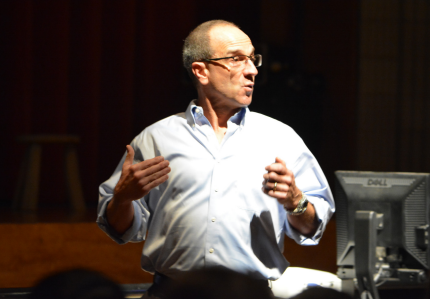Presentation challenges freshmen to prevent bullying

Advocating for change– Psychology and sociology teacher Mike Baxer speaks to freshmen about the dangers of bullying. Freshmen listened to it as a part of a special programming while sophomores and juniors took the Preliminary Scholastic Aptitude Test (PSATs).
November 1, 2016
As part of an annual special program, freshmen attended a presentation by psychology and sociology teacher Mike Baxer, who discussed the dangers of bullying. His presentation brought awareness to bullying and informed freshmen about how they can stand up to bullying them they see it.
“The other piece of it was not just to present information, but to present a challenge to the freshmen class,” social worker Chris Garrahan said.
While students and faculty filed into the auditorium, The Fray’s, “How to Save a Life” played through the loudspeakers. When the song ended, Baxer began by showing a series of real-life bully victims who ultimately committed suicide, telling their personal stories in detail.
“A lot of the times people, when they are told about this kind of stuff, it brings a reality to them, that it does hurt people sometimes. When people are more aware of that, they can think about their actions,” freshman Kiara Azarigian said.
Baxer was approached years ago with the idea of presenting bullying to the freshmen class while sophomores and juniors took their SATs. He used his own experiences with bullying as a drive to present his topic. Diagnosed with Asperger’s, his oldest daughter became a target for bullies from a young age and into high school.
“As a parent, there’s nothing you want more than for your child to be happy, and my child was miserable. And I think it could have been prevented if just a few people stood up and said stop. But no one stood up,” Baxer said.
With several supports in place, she eventually found some peace and learned how to deal with the situation. In part of telling her story, Baxer discussed the importance of understanding how to respond to someone who is a victim of bullying. Garrahan echoed this message at the end of the presentation.
“I thought it was very important, he was telling us this to help us think of other people and not just ourselves,” freshman David Bobbin said.
Bobbin believed that the presentation was very well done, and that Baxer illuminated the topic in an engaging yet serious manner. Part of this was realizing that not all bullying behaviors are intentional but also subconscious.
“It’s all in degrees. You can be mean without having any intention to be mean. Or you can be mean because you’re trying to be mean, but you’re doing it in a real subtle way. Or you can just be flat-out mean. Or you can repeatedly be mean to the same people, and then you’re a bully. It’s all on a scale,” Garrahan said.
In addition, there was talk about mentioning micro-aggressions and having follow-ups on the topic to keep the discussion of bullying ongoing.
“In high school we can be put under a lot of stress, so that might cause us to act out. If they tell us this, we can be more aware of how to help, and how do not [bully] in the first place,” Azarigian said.
There are also efforts being made to intentionally coincide social justice club meetings, such as the Gay Straight Alliance (GSA), around the time of this presentation, as well as an increase in communication between faculty about the changing environment of the school.
“It’s very possible to create a climate in a school where that behavior is unacceptable. Where the behavior is such that if it did happen, it would be addressed so promptly by, not just the authority, but by peers; that this is not okay,” Garrahan said.

